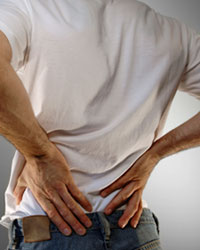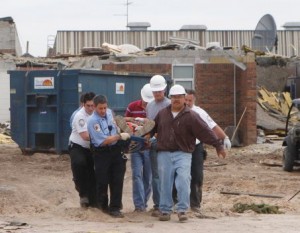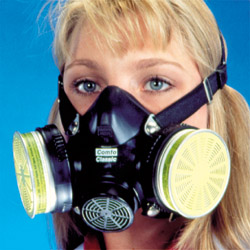 The Occupational Safety and Health Administration (OSHA) measures illness and injury by using an acronym called DART. DART stands for “Days Away, Restricted and Transferred.” Companies use a formula designed by OSHA to calculate their DART. The variables used in this formula come from the company’s OSHA 300 form. The OSHA 300 form is used to track recordable injuries and illnesses within a given company in a given year.
The Occupational Safety and Health Administration (OSHA) measures illness and injury by using an acronym called DART. DART stands for “Days Away, Restricted and Transferred.” Companies use a formula designed by OSHA to calculate their DART. The variables used in this formula come from the company’s OSHA 300 form. The OSHA 300 form is used to track recordable injuries and illnesses within a given company in a given year.
Category: Safety at Work
Avoidable Workplace Health and Safety Hazards
 When it comes to non-fatal workplace injuries, the clear leaders are incidents of ergonomic problems and overexertion. They affect people in manufacturing, service, and office settings and regulatory bodies are increasingly cracking down on employers who ignore their employees ergonomic needs. Furthermore, because these injuries can give rise to chronic conditions, they result in one of the higher rates of lost work time.
When it comes to non-fatal workplace injuries, the clear leaders are incidents of ergonomic problems and overexertion. They affect people in manufacturing, service, and office settings and regulatory bodies are increasingly cracking down on employers who ignore their employees ergonomic needs. Furthermore, because these injuries can give rise to chronic conditions, they result in one of the higher rates of lost work time.
via 9 Avoidable Workplace Health and Safety Hazards | Inc.com.
Communication Key to Workplace Safety
 Dangerous working conditions not only pose threats to the safety and livelihood of workers, but also have major ramifications that can affect families, employers and communities. Research indicates the importance of the availability of safety information and presentation tips for organizations to help create more effective messages for employees:
Dangerous working conditions not only pose threats to the safety and livelihood of workers, but also have major ramifications that can affect families, employers and communities. Research indicates the importance of the availability of safety information and presentation tips for organizations to help create more effective messages for employees:
- Get personal – Research showed that workers preferred to receive important information verbally from their immediate supervisors. Having direct interaction about safety with the same individual in charge of productivity conveys the importance of the safety message.
- Keep the message simple – Too many details are likely to create barriers to efficacy and cause important safety messages to be ignored. Organizations should, however, have more information available to those who seek it out.
- Encourage positive safety behaviors – Organizations also should develop messages that focus on how to initiate pre-safety messages. Messages emphasizing the initiation of new safety behaviors (wearing safety goggles) are more like to be successful than messages that focus on the termination of certain behaviors (no horseplay).
- Deliver messages through more than one medium – By asking workers to engage a safety message in different ways (watch it, hear it, read it), supervisors can better ensure that more workers receive it. This does not require multiple safety messages, but does require delivering the same message over various channels.
via Trust in Communication Key to Workplace Safety | Safety content from EHS Today.
Accident Investigation
 Thousands of accidents occur throughout the United States every day. The failure of people, equipment, supplies, or surroundings to behave or react as expected causes most of them. Accident investigations determine how and why these failures occur. By using the information gained through an investigation, a similar, or perhaps more disastrous, accident may be prevented. It is important to conduct accident investigations with prevention in mind.
Thousands of accidents occur throughout the United States every day. The failure of people, equipment, supplies, or surroundings to behave or react as expected causes most of them. Accident investigations determine how and why these failures occur. By using the information gained through an investigation, a similar, or perhaps more disastrous, accident may be prevented. It is important to conduct accident investigations with prevention in mind.
Traumatic Occupational Injury
 In 2010, there were an estimated 139,064,000 civilian workers in the U.S. private and public sector employed labor force, according to the Bureau of Labor Statistics Current Population Survey . Each day, many of these workers suffer injury, disability, and death from workplace incidents. In 2010, more than 4,500 U.S. workers died from occupational injuries. Although difficult to enumerate, annually about 49,000 deaths are attributed to work-related illnesses. In 2010, an estimated 3.9 million workers in private industry and state and local government had a nonfatal occupational injury or illness. Of those workers, 2 million were transferred, placed on work restrictions, or took time away from work. In the same year an estimated 2.6 million workers were treated in emergency departments for occupational injuries and illnesses, and approximately 110,000 of these workers were hospitalized (NIOSH, unpublished data, 2012).
In 2010, there were an estimated 139,064,000 civilian workers in the U.S. private and public sector employed labor force, according to the Bureau of Labor Statistics Current Population Survey . Each day, many of these workers suffer injury, disability, and death from workplace incidents. In 2010, more than 4,500 U.S. workers died from occupational injuries. Although difficult to enumerate, annually about 49,000 deaths are attributed to work-related illnesses. In 2010, an estimated 3.9 million workers in private industry and state and local government had a nonfatal occupational injury or illness. Of those workers, 2 million were transferred, placed on work restrictions, or took time away from work. In the same year an estimated 2.6 million workers were treated in emergency departments for occupational injuries and illnesses, and approximately 110,000 of these workers were hospitalized (NIOSH, unpublished data, 2012).
Each year occupational injuries and illnesses cause employers, workers, and society to pay tremendous costs for workers’ compensation and other insurance, medical expenses, lost wages and productivity, and the personal and societal costs associated with day to day living for injured and ill workers. In 2009, employers spent $74 billion on workers’ compensation insurance alone.
via CDC – Directory of NIOSH Traumatic Occupational Injury Resources.
Respirators
 Respirators protect the user in two basic ways. The first is by the removal of contaminants from the air. Respirators of this type include particulate respirators, which filter out airborne particles; and “gas masks” which filter out chemicals and gases. Other respirators protect by supplying clean respirable air from another source. Respirators that fall into this category include airline respirators, which use compressed air from a remote source; and self-contained breathing apparatus (SCBA), which include their own air supply.
Respirators protect the user in two basic ways. The first is by the removal of contaminants from the air. Respirators of this type include particulate respirators, which filter out airborne particles; and “gas masks” which filter out chemicals and gases. Other respirators protect by supplying clean respirable air from another source. Respirators that fall into this category include airline respirators, which use compressed air from a remote source; and self-contained breathing apparatus (SCBA), which include their own air supply.
via CDC – Respirators – NIOSH Workplace Safety and Health Topic.
Portable Ladder Safety
 Falls from portable ladders (step, straight, combination and extension) are one of the leading causes of occupational fatalities and injuries.
Falls from portable ladders (step, straight, combination and extension) are one of the leading causes of occupational fatalities and injuries.
- Read and follow all labels/markings on the ladder.
- Avoid electrical hazards! – Look for overhead power lines before handling a ladder. Avoid using a metal ladder near power lines or exposed energized electrical equipment.
- Always inspect the ladder prior to using it. If the ladder is damaged, it must be removed from service and tagged until repaired or discarded.
- Always maintain a 3-point (two hands and a foot, or two feet and a hand) contact on the ladder when climbing. Keep your body near the middle of the step and always face the ladder while climbing (see diagram).
- Only use ladders and appropriate accessories (ladder levelers, jacks or hooks) for their designed purposes.
- Ladders must be free of any slippery material on the rungs, steps or feet.
- Do not use a self-supporting ladder (e.g., step ladder) as a single ladder or in a partially closed position.
- Do not use the top step/rung of a ladder as a step/rung unless it was designed for that purpose.
- Use a ladder only on a stable and level surface, unless it has been secured (top or bottom) to prevent displacement.
- Do not place a ladder on boxes, barrels or other unstable bases to obtain additional height.
- Do not move or shift a ladder while a person or equipment is on the ladder.
- An extension or straight ladder used to access an elevated surface must extend at least 3 feet above the point of support (see diagram). Do not stand on the three top rungs of a straight, single or extension ladder.
- The proper angle for setting up a ladder is to place its base a quarter of the working length of the ladder from the wall or other vertical surface (see diagram).
- A ladder placed in any location where it can be displaced by other work activities must be secured to prevent displacement or a barricade must be erected to keep traffic away from the ladder.
- Be sure that all locks on an extension ladder are properly engaged.
- Do not exceed the maximum load rating of a ladder. Be aware of the ladder’s load rating and of the weight it is supporting, including the weight of any tools or equipment.
Safety – What is a Near Miss?
 A Near Miss is an unplanned event that did not result in injury, illness, or damage – but had the potential to do so. Only a fortunate break in the chain of events prevented an injury, fatality or damage; in other words, a miss that was nonetheless very near.
A Near Miss is an unplanned event that did not result in injury, illness, or damage – but had the potential to do so. Only a fortunate break in the chain of events prevented an injury, fatality or damage; in other words, a miss that was nonetheless very near.
A faulty process or management system invariably is the root cause for the increased risk that leads to the near miss and should be the focus of improvement. Other familiar terms for these events are a “close call,” a “narrow escape,” or in the case of moving objects, “near collision” or a “near hit.”
Bloodborne Pathogens and Needlestick Prevention
 What are bloodborne pathogens?
What are bloodborne pathogens?
Bloodborne pathogens are infectious microorganisms in human blood that can cause disease in humans. These pathogens include, but are not limited to, hepatitis B (HBV), hepatitis C (HCV) and human immunodeficiency virus (HIV). Needlesticks and other sharps-related injuries may expose workers to bloodborne pathogens. Workers in many occupations, including first aid team members, housekeeping personnel in some industries, nurses and other healthcare personnel may be at risk of exposure to bloodborne pathogens.
What can be done to control exposure to bloodborne pathogens?
In order to reduce or eliminate the hazards of occupational exposure to bloodborne pathogens, an employer must implement an exposure control plan for the worksite with details on employee protection measures. The plan must also describe how an employer will use a combination of engineering and work practice controls, ensure the use of personal protective clothing and equipment, provide training , medical surveillance, hepatitis B vaccinations, and signs and labels, among other provisions. Engineering controls are the primary means of eliminating or minimizing employee exposure and include the use of safer medical devices, such as needleless devices, shielded needle devices, and plastic capillary tubes.
via Safety and Health Topics | Bloodborne Pathogens and Needlestick Prevention.
The 10 most dangerous jobs in America
 According to a September report from the Bureau of Labor Statistics BLS, fisherman, loggers and pilots were the three deadliest in the United States in 2011. The organization recently examined the occupations with the highest rate of work-related deaths and found that of all U.S. workers, fishermen are the most likely to die on the job.
According to a September report from the Bureau of Labor Statistics BLS, fisherman, loggers and pilots were the three deadliest in the United States in 2011. The organization recently examined the occupations with the highest rate of work-related deaths and found that of all U.S. workers, fishermen are the most likely to die on the job.
Here is the full list of work-related deaths in 2011 per 100,000 workers:
- Fisherman 121.2
- Loggers 102.4
- Pilots 57.0
- Farmers and Ranchers 25.3
- Police Officers 18.6
- Construction Workers 15.7
- National Average 3.5
- Firefighters 2.5
- Cashiers 1.6
- Office Admin 0.6
- Business and Finance Staff 0.5
